
Drip irrigation in different landscape situations
Drip irrigation can be used to water trees, plants in containers, raised beds, and many other landscape situations. The amount of water needed and frequency of application varies greatly depending on plant species, soil conditions, and the local environment. Here are some examples:
- Dense landscapes
- Groundcovers All require adequate moisture to become established. Once established, plants can tolerate less frequent watering. Most benefit from supplemental irrigation 1-2 times a month in summer.
- Turf In many cases, more water is applied to lawns than any other area of a landscape, in part due to poor uniformity (uneven application of water) of sprinkler systems, which wastes significant amounts of water.
- Water early in the morning to reduce evaporation and the effect of wind on sprinkler patterns.
- Water lawns separately from trees, shrubs, and groundcovers.
- Control weeds, which compete for water, light, and nutrients.
- Dethatch in spring. Fertilize moderately. Maintain proper mowing height (3-4” in summer).
- Sparsely planted landscapes
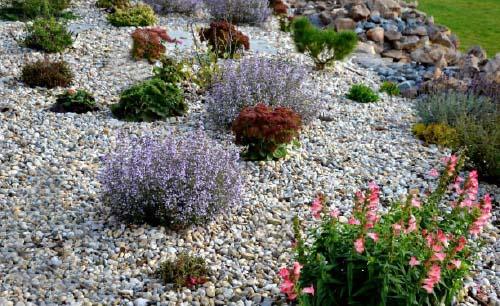
If the root span of selected plants at maturity will not intertwine, use pressure-compensating emitters placed in distribution tubing instead of inline drip tubing. As the plant grows move emitters out to the new drip line of the plant.
Add a layer of organic matter (mulch) 2-4 inches deep on top of the soil surface, keeping at least 6” from woody stems or trunks. Mulches reduce water evaporation from the soil, minimize weed competition, and can improve soil structure.
- Newly planted landscape
A newly planted landscape will require watering on a daily schedule for 1-2 weeks, moving to every 2-3 days weekly as the plant shows growth, new leaves, for example. After 4-8 weeks water weekly. Remember to water at the drip line of the plant.
Hot and/or windy weather will shorten the watering intervals.
Before planting, dig a hole twice as wide and almost as deep as the plant’s pot, leaving room for applying compost/mulch. Fill the hole with water and let it soak in. Do this twice.
Water plants deeply as soon as they are planted, letting the water soak in.
- Trees
Newly planted trees and shrubs should be frequently irrigated so that the root ball and soil immediately around it are kept adequately moist during the first season of establishment. As they mature, deeper and less frequent irrigation is preferred to a depth of 1-3 feet to encourage deep and structurally strong root systems. Because roots spread laterally beyond the drip line of a tree, irrigate outward as well as downward.
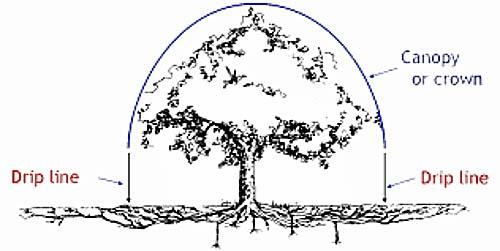
Mature trees should receive enough water to wet most of their root zone every 10-14 days in the summer. Trees require less-frequent irrigation in the spring and fall and often need little or no irrigation in the winter.
- Shrubs
Newly planted shrubs should be frequently irrigated so that the root ball and the soil immediately around it are kept adequately moist during the first year of establishment. Water daily the first month or so after planting then usually 1-3 times per week during the establishment period. Applying a layer of mulch 2-4 inches thick starting several inches from the base of the shrub out as close to the drip line as feasible retains moisture and prevents weeds.
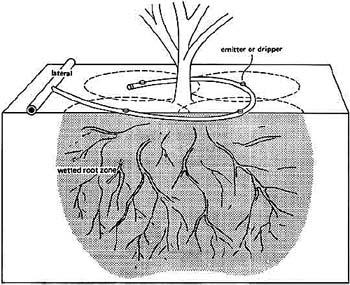
- Perennials
Newly planted low-water-use perennials require a relatively frequent and uniform supply of water until roots are established. Once established, irrigation frequency can be reduced to 1-2 times per week. Enough water to re-wet the root system should be applied during each irrigation.
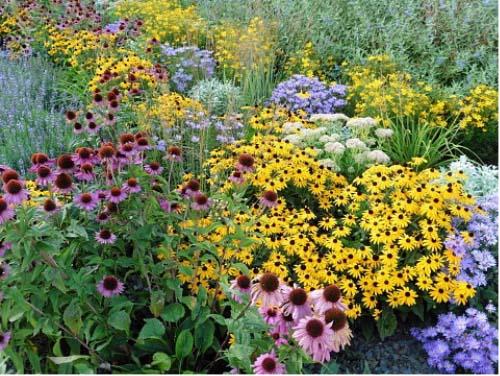
Succulents are plants with thick, fleshy stems and leaves that collect and store water efficiently. While many succulents thrive in full sun with little water, others may need occasional water or part/full shade. Some are hardy to sub-zero temperatures while others are frost tender. In general, succulents do best with infrequent watering, as they approach dryness, rather than keeping the soil moist. Their fleshy stems will easily rot if they are overwatered.
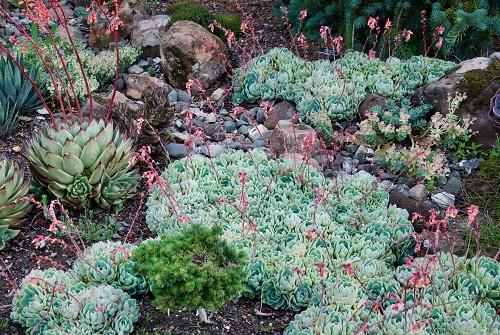
- Raised beds, including vegetables
- Plant Containers - Inline drip is a good choice for watering your containers and is an easy DIY project. Use ¼” inline drip with 6” spacing. Below are photos of what this looks like and list of components.
- ½” distribution tubing
- ¼” straight connector
- ¼” distribution tubing
- ¼” micro-flow valve (shutoff)
- ¼” inline drip tubing, 6” spacing, 0.5 GPH
- goof plug
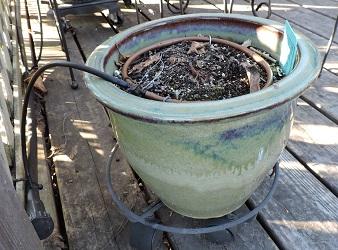 |
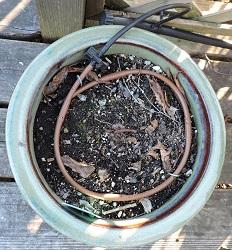 |
Layouts for a number of different landscape applications
- Grid, Snake, and Ring Drip Layouts, UC ANR
- Drip Irrigation Layout Examples, Contra Costa County
Note: Permission to use granted 12/5/22 by Lori Palmquist
The topics outlined below will help you install a drip system.
- Drip irrigation vs other irrigation methods
- How to get started
- Drip irrigation management
- Key considerations when implementing a drip system
- Drip irrigation basics
- Drip irrigation in different landscape situations
- Determining how much water to apply and how often
- Maintaining an irrigation system
- How to get help







